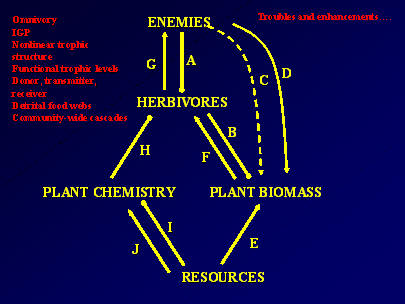|
|
Rainforest Experiments
|
|
|
||||||||||||||||||||
|
|
In
the summer of 2005 I had the pleasure of spending three weeks working in the
lab of the Department of Ecology and Evolutionary Biology at Tulane
University with Dr. Lee Dyer and his experienced team. While in the lab
I was allowed to conduct chemistry experiments, rear Spodoptera exigua (Beet army worm)
caterpillars, conduct an experiment with Spodoptera exigua and Piper imperiale
(a rainforest understory plant), and assist in other areas. Trophic Cascades Through the study
of the trophic cascades (where a predator affects the plant biomass by
consuming the herbivore) present in the rainforest, Dr. Dyer is looking at
the effects of plant allelochemicals on interactions between plants
and arthropods in a natural and managed ecosystem. The work is conducted
both in the lab and in the field. The field studies are conducted in La
Selva, Costa Rica; Yanayacu, Equador; and the Southwest Research Station in
Arizona. This work has implications for both agriculture and medicine. Dr. Dyer has
developed an intimate relationship with the genus Piper, specifically Piper imperiale and Piper cenocladum. He is particularly
interested in Trophic Cascades in relation to each of these. A trophic
cascade is a food web that involves a predator, a herbivore, and a plant or
plant biomass. Below is an
illustration of the Piper cenocladum tritrophic cascade.
Piper Chemistry It has taken seven
years of work to develop a way to isolate the three amides (plant secondary
metabolites) found in the Piper cenocladum plant. Below is a picture of
these amides.
The work to
isolate the imides in Piper imperiale also orginated with Dr. Dyer's work.
According to Dr. Dyer, "Results from our previous work indicated that
scientific amides and imides (plant secondary metabolites) in understory
shrubs (Piper spp.)
play important roles in determining the diversity of arthropods associated
with these shrubs and their interactions." Much of the work has focused
on the Piper cenocladum. Previous work in the
lab looked at the plant allelochemicals found in Piper cenocladum. These allelochemicals
are known as amides. Through their work in the lab they were able to
isolate two imides and were at the forefront in developing the system for
isolating these chemicals. This work led to the discovery of the two
imides in the Piper imperiale; alkene and pipleroxide. This is where my work
in chemistry was focused in the lab. I was able to follow the
procedures developed through years of work in the lab to isolate these two
compounds from nine different plant samples collected in the field in La
Selva, Costa Rica.
Piper Imperiale
Chemistry Using the protocols
developed over years of work to isolate the amides from Piper cenocladum in the lab, I used nine
different plant samples of Piper imperiale gathered in La Selva, Costa
Rica to isolate the previously identified plant imides alkene and pipleroxide. The process takes several
days and involves multiple stages of extraction. The first step in this
process utilizes ethanol and is a two-step process. Plant samples are
weighed and put into a flask with a predetermined amount of ethanol and
stirred overnight. The samples are decanted and then processed on a rotovap
to pull off the liquid. Additional ethanol is then added and the
process is repeated. The third step
involves chloroform partitioning. The sample is processed using
chloroform and in the final stages the sample is processed on the rotovap. Finally the samples
are placed into vials so that they can be processed with the gas chromometer. The gas chromometer ......
Raising
Spodoptera exigua Part of my work in
the lab was assisting in the care and feeding of the Spodoptera exigua the larva of the Beet Army
Worm. These caterpillars are used in lab work because of their ease in
rearing. Some of the spodoptera are used to help raise Cotesia
marginiventris
a parasitic
wasp; a common parasatoid of this species. Parasatoids are one of the most
diverse groups of organisms. Their larva lives off the host and
consumes it as it grows. Part of a parasatoid's lifecycle is to kill
its host. The Cotesia marginiventris lays its egg in the body of the Spodoptera exigua; the larva emerges two days
later and then forms a pupa of its own. This pupa then becomes an adult
Cotesia
marginiventris
wasp. Below
is an illustration of the lifecycle of the Spodoptera exigua.
The Experiment Piper
imperiale and
Spodoptera
exigua The culmination of
my work was to conduct my own experiment. I used the format that
Dr. Dyer used with Piper cenocladum and Spodoptera frugiperda. This experiment used the Piper
imperiale and Spodoptera exigua and was designed to determine the effect if
any of the imides (alkene and Pipleroxide) or the plant on the Spodoptera
exigua.
The experiment
involved feeding Spodoptera exigua nine different diet treatments. Each group
consisted of twelve (12) caterpillars. The amount of each imide was based on
the quanitities found in actual plant samples. The diet groups were as
follows:
|
|
Trophic
Cascades |
||||||||||||||||||||


